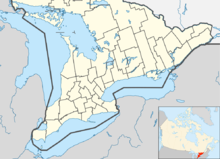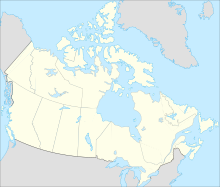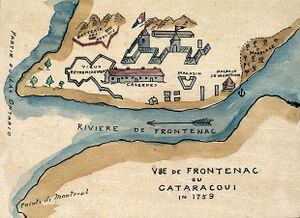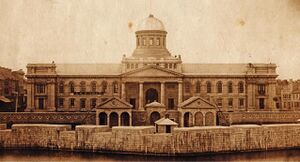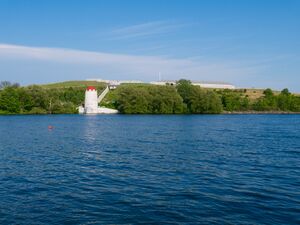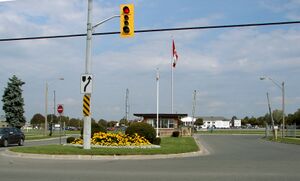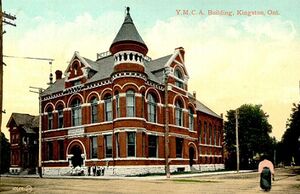كنگستون، أونتاريو
Kingston
Cataraqui | |
|---|---|
| City of Kingston | |
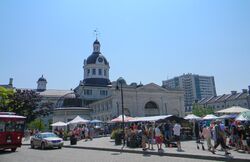 Kingston City Hall | |
| الكنية: Limestone City | |
| الشعار: Antiquitate Civilitate Humanitate (Latin) ("A Civil And Creative Community with a Proud Past") | |
| الإحداثيات: 44°14′N 76°30′W / 44.233°N 76.500°W | |
| Country | Canada |
| Province | Ontario |
| Established | 1673 (as Fort Cataraqui; later renamed Fort Frontenac) |
| Incorporated | 1838 (as town); 1846 (as city) |
| Amalgamated | 1998 (with Kingston and Pittsburgh Townships) |
| الحكومة | |
| • City Mayor | Bryan Paterson[1] |
| • Governing Body | Kingston City Council |
| • MP (Federal) | Mark Gerretsen (LPC) Scott Reid (CPC) |
| • MPP (Provincial) | Ian Arthur (NDP) Randy Hillier (Independent) |
| المساحة | |
| • البر | 451٫19 كم² (174٫21 ميل²) |
| • العمران | 1٬906٫82 كم² (736٫23 ميل²) |
| المنسوب | 93 m (305 ft) |
| التعداد (2016) | |
| • City (single-tier) | 123٬798 |
| • الكثافة | 274٫4/km2 (711/sq mi) |
| • العمرانية | 161٬175 |
| • الكثافة العمرانية | 83٫1/km2 (215/sq mi) |
| source:[2] | |
| منطقة التوقيت | UTC−05:00 (EST) |
| • الصيف (التوقيت الصيفي) | UTC−04:00 (EDT) |
| Postal code span | K7K through K7P |
| مفتاح الهاتف | 613 343 |
| GDP (Kingston CMA) | CA$8.7 billion (2016)[3] |
| GDP per capita (Kingston CMA) | CA$54,022 (2016) |
| الموقع الإلكتروني | www.cityofkingston.ca |
كنگستون Kingston هي مدينة في شرق أونتاريو، كندا. وتقع على الطرف الشرقي لبحيرة أونتاريو، عند بداية St. Lawrence River and at the mouth of the Cataraqui River (south end of the Rideau Canal). The city is midway between Toronto, Ontario, and Montreal, Quebec. The Thousand Islands tourist region is nearby to the east. Kingston is nicknamed the "Limestone City" because of the many heritage buildings constructed using local limestone.
Growing European exploration in the 17th century, and the desire for the Europeans to establish a presence close to local Native occupants to control trade, led to the founding of a French trading post and military fort at a site known as "Cataraqui" (generally pronounced "kah-tah-ROCK-way") in 1673. This outpost, called Fort Cataraqui, and later Fort Frontenac, became a focus for settlement. Since 1760, the site of Kingston, Ontario, was in effective British possession.[4] Cataraqui would be renamed Kingston after the British took possession of the fort, and Loyalists began settling the region in the 1780s.
Kingston was named the first capital of the مقاطعة كندا المتحدة on February 10, 1841.[5] While its time as a capital city was short (ending in 1844), the community has remained an important military installation. Kingston was the county seat of Frontenac County until 1998. Kingston is now a separate municipality from the County of Frontenac.
التاريخ
تاريخ التسمية وأصل الاسم
A number of origins of "Cataraqui", Kingston's original name, have been postulated. One theory is that it is derived from the Iroquois word that means "the place where one hides".[6] The name may also be a derivation of Indigenous words that mean "impregnable", "muddy river", "place of retreat", "clay bank rising out of the water", "where the rivers and lake meet", or "rocks standing in water".[7][8][9][10]
Cataraqui was referred to as "the King's Town" or "King's Town" by 1787, in honour of King George III. The name was shortened to "Kingston" in 1788.[11][12] Cataraqui today is an area around the intersection of Princess Street and Sydenham Road, where the village of Cataraqui (formerly known as Waterloo) was located. Cataraqui is also the name of a municipal electoral district.
Early Indigenous habitation
Archaeological evidence suggests people lived in the Kingston region as early as the Archaic Period (about 9,000–3,000 years ago).[13][14] Evidence of Late Woodland Period (about 1000–500 AD) early Iroquois occupation also exists.[15] The first more permanent encampments by Indigenous people in the Kingston area began about 500 AD.[16] The group that first occupied the area before the arrival of the French was probably the Wyandot people (Hurons), who were later displaced by Iroquoian groups.[16]
At the time the French arrived in the Kingston area, Five Nations Iroquois (Haudenosaunee) had settled along the north shore of Lake Ontario.[17] Although the area around the south end of the Cataraqui River was often visited by Iroquois and other groups, Iroquois settlement at this location only began after the French established their outpost.[18] By 1700, the north shore Iroquois had moved south, and the area once occupied by the Iroquois (which includes Kingston) became occupied by the Mississaugas who had moved south from the Lake Huron and Lake Simcoe regions.[19]
French settlement and Fort Frontenac
European commercial and military influence and activities centred on the fur trade developed and increased in North America in the 17th century. Fur trappers and traders were spreading out from their centres of operation in New France. French explorer Samuel de Champlain visited the Kingston area in 1615.[20]
To establish a presence on Lake Ontario for the purpose of controlling the fur trade with local indigenous people, Louis de Buade de Frontenac, Governor of New France established Fort Cataraqui, later to be called Fort Frontenac, at a location known as Cataraqui in 1673.[20] The fort served as a trading post and military base, and gradually attracted indigenous and European settlement. In 1674, René-Robert Cavelier, Sieur de La Salle was appointed commandant of the fort. From this base, de La Salle explored west and south as far as the Gulf of Mexico.[20] The fort was rebuilt several times and experienced periods of abandonment. The Iroquois siege of 1688 led to many deaths, after which the French destroyed the fort, but would rebuild it. The British destroyed the fort during the Battle of Fort Frontenac (Seven Years' War) in 1758 and its ruins remained abandoned until the British took possession and partially reconstructed it in 1783. The fort was renamed Tête-de-Pont Barracks in 1787. It was turned over to the Canadian military in 1870–71 and is still being used by the military. It was renamed Fort Frontenac in 1939.[21] Partially reconstructed parts of the original fort can be seen today at the western end of the La Salle Causeway.
Loyalist settlement
In 1783, Frederick Haldimand, governor of the Province of Quebec directed Deputy Surveyor-General John Collins to lay out a settlement for displaced British colonists, or Loyalists, who were fleeing north because of the American Revolutionary War and "minutely examine the situation and site of the Post formerly occupied by the French, and the land and country adjacent". Haldimand had originally considered the site as a possible location to settle loyal Mohawks.[22] The survey would also determine whether Cataraqui was suitable as a navy base since nearby Carleton Island on which a British navy base was located had been ceded to the Americans after the war. Holland's report about the old French post mentioned "every part surpassed the favorable idea I had formed of it", that it had "advantageous Situations" and that "the harbour is in every respect Good and most conveniently situated to command Lake Ontario".[22] Major John Ross, commanding officer of the King's Royal Regiment of New York at Oswego partly rebuilt Fort Frontenac in 1783. As commander, he played a significant role in establishing the Cataraqui settlement.
To facilitate settlement, the British Crown entered into an agreement with the Mississaugas in October 1783 to purchase land east of the Bay of Quinte. Known as the Crawford Purchase, this agreement enabled settlement for much of the eastern section of the north shore of Lake Ontario.[23][24] With the completion of the Mississauga agreement, settlement could proceed, although the planning of the layout of the townsite had not waited for the completion of the negotiations. The area was surveyed, and the survey report mentioned the area was deemed to have productive lands, abundant resources, a good harbour and an existing townsite. These requirements were considered ideal to settle the Loyalists.[25] Three kinds of refugee Loyalists would settle at Cataraqui: ‘associated’ or ‘incorporated’ Loyalists who were organized into companies under militia officers, provincial colonial regiments and their dependents, and unincorporated Loyalists who came to Canada independently.[26]
Many Loyalist refugees had at first settled on Carleton Island, and operated businesses there. When the Island was ceded to the United States after the Revolutionary War, these Loyalists, along with their businesses, relocated to Cataraqui.
Notable Loyalists who settled in the Cataraqui area include Molly Brant (the sister of Six Nations leader Joseph Brant); businessman and political figure Richard Cartwright; John Stuart, a clergyman, missionary and educator who arrived in 1785; and militia captain Johan Jost Herkimer. A group of Loyalists from New York State, led by Captain Michael Grass who arrived in 1784 after sailing from New York and up the St. Lawrence River, established a camp south of Fort Frontenac at Mississauga Point.[27][28] The first name given to the settlement by the Loyalists was King's Town, which would eventually develop into the current appellation.[10]
The first high school (grammar school) in what later became the province of Ontario was established in Kingston in 1792 by Loyalist priest John Stuart, which evolved into Kingston Collegiate and Vocational Institute.
War of 1812, and development
During the War of 1812, Kingston (with a population of 2,250)[29] was a major military centre. It was the base for the Lake Ontario division of the Great Lakes British naval fleet, which engaged in a vigorous arms race with the American fleet based at Sackets Harbor, New York for control of Lake Ontario. The Provincial Marine quickly placed ships into service and troops were brought in. A Royal Naval detachment built warships in order to control Lake Ontario.[20] Fortifications and other defensive structures were built. The first Fort Henry was built during this time to protect the dockyards in Navy Bay.[30] This fort was replaced by a more extensive fort on Point Henry in 1813.[31][20] The present limestone citadel, constructed between 1832 and 1836, was intended to defend the recently completed Rideau Canal (opened in 1832) at the Lake Ontario end as well as the harbour and the naval dockyard.[32] In 1843, the advanced battery overlooking the lake to the south was completed when the casemated commissariat stores and magazines were built. Fort Henry was garrisoned by British until 1871. It was restored starting in 1936 and is a popular tourist attraction, now part of a World Heritage Site.[30]
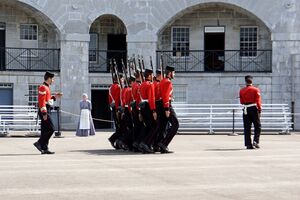
Kingston's location at the Rideau Canal entrance to Lake Ontario made it the primary military and economic centre of Upper Canada after canal construction was completed in 1832. It was incorporated as a town in 1838; the first mayor of Kingston was Thomas Kirkpatrick.[20] Kingston had the largest population of any centre in Upper Canada until the 1840s. Kingston was incorporated as a city in 1846.
Kingston became an important port as businesses relating to transshipment, or forwarding, grew. Since Kingston was at the junction of the St. Lawrence River and Lake Ontario, commodities shipped along the lake from the west such as wheat, flour, meat, and potash were unloaded and stored at Kingston to await transfer to vessels that could navigate the risky St. Lawrence. With the completion of the Rideau Canal, cargoes could be transported in a safer fashion since the St. Lawrence River route could be bypassed. The canal was a popular route for transporting lumber.[33]
Regiopolis College (for training priests) was incorporated in March 1837, and in 1866 the College was given full degree-granting powers, although these were rarely used and the college closed in 1869.[20] The building became the Hotel Dieu Hospital in 1892. The College reopened at another location in 1896.[34] Queen's University, originally Queen's College,[20] one of the first liberal arts universities, first held classes in March 1842; established by the Presbyterian Church, it later became a national institution.[35] The Royal Military College of Canada (RMC) was founded in 1876.
Kingston Penitentiary, Canada's first large federal penitentiary, was established in 1835 and operated until 2013. Several more prisons would be established in later years in the greater Kingston area, including the federal Prison for Women (1930, closed in the 1990s), Millhaven Penitentiary, Collins Bay, Frontenac, and Joyceville Institutions.
During the Upper Canada Rebellion, 1837–38, much of the local militia was posted in Kingston, under Lt. Col. Richard Henry Bonnycastle who completed construction of the new Fort Henry.
Canada's first capital, briefly
Governor General Lord Sydenham chose Kingston as the first capital of the united Canadas, and it served in that role from 1841 to 1844. The first meeting of the Parliament of the Province of Canada on June 13, 1841, was held on the site of what is now Kingston General Hospital. The city was considered too small and lacking in amenities, however, and its location near the border made it vulnerable to American attack. Consequently, the capital was moved to Montreal in 1844,[36] and it alternated between Quebec City and Toronto from 1849 until Ottawa, then a small lumber village known as Bytown, was selected as the permanent capital by Queen Victoria. Subsequently, Kingston's growth slowed considerably and its national importance declined.
In 1846, with a population of 6,123, Kingston was incorporated as a city, with John Counter as the first mayor.[20] By that time, there were stone buildings, both residential and commercial. The market house was particularly noteworthy as "the finest and most substantial building in Canada" which contained many offices, government offices, space for church services, the post office, the City Hall (completed in 1844)[37] and more. Five weekly newspapers were being published. Fort Henry and the marine barracks took up a great deal of space. Kingston Penitentiary had about 400 inmates. (The prison opened in 1835, with a structure intended to reform the inmates, not merely to hold or punish them.)[38] Industry included a steam grist mill, three foundries, two shipbuilders, ship repairers and five wagon makers; tradesmen of many types also worked here. All freight was shipped by boat or barges and ten steamboats per day were running to and from the town. Five schools for ladies and two for boys were operating, and the town had four bank agency offices. There were ten churches or chapels and the recently opened Hotel Dieu hospital was operated by sisters with the Religious Hospitallers of St. Joseph as a charity.[39]
Both Hotel Dieu and Kingston General Hospital (KGH) cared for victims of the typhus epidemic of 1847.[40] The KGH site held the remains of 1,400 Irish immigrants who had died in Kingston in fever sheds along the waterfront, during the typhus epidemic of 1847, while fleeing the Great Famine. They were buried in a common grave. The remains were re-interred at the city's St. Mary's Cemetery in 1966.[41] In 1995, KGH was designated a National Historic Site of Canada, because it is "the oldest public hospital in Canada still in operation with most of its buildings intact and thus effectively illustrates the evolution of health care in Canada in the 19th and 20th centuries".[42]
In 1848, the Kingston Gas Light Company began operation. (Gas lamps would be used until 1947.) By that time, the town was connected to the outside world by telegraph cables.[20]
The Grand Trunk Railway arrived in Kingston in 1856, providing service to Toronto in the west, and to Montreal in the east. Its Kingston station was two miles north of downtown. Kingston became an important rail centre, for both passengers and cargo, due to difficulty travelling by ship through the rapids-and-shoal-filled river.
By 1869, the population had increased to 15,000, and there were four banks. There were two ship building yards.[43]
Kingston was the home of Canada's first Prime Minister, John A. Macdonald. He won his first election to Kingston City Council in 1843, and would later represent the city for nearly 50 years at the national level, both before and after Confederation in 1867. One of his residences in Kingston, Bellevue House, is now a popular National Historic Site of Canada open to the public, and depicting the house as it would have been in the 1840s when he lived there.
In the early hours of April 18, 1840, a dock fire, fanned by high winds, spread to a warehouse containing between 70 and 100 kegs of gunpowder. The resulting explosion spread the fire throughout the city's downtown area, destroying a large number of buildings, including the old city hall. To prevent similar incidents from occurring in future, the city began building with limestone or brick. This rebuilding phase was referred to as "the Limestone Revolution" and earned the city the nickname "The Limestone City".[44][45][46]
More recent developments
The Canadian Locomotive Company was at one time the largest locomotive works in the British Empire and the Davis Tannery was at one time the largest tannery in the British Empire. The tannery operated for a century and was closed in 1973.[47] Other manufacturing companies included the Marine Railway Company, which built steamboats; the Victoria Iron Works, which produced iron in bars from scrap; several breweries; a distillery; and two soap and candle manufacturers.[48] (By the start of the 21st century, most heavy industry would leave the city and their former sites would be gradually rehabilitated and redeveloped.)
A telephone system began operation in Kingston in 1881; at that time the population was 14,091. Electricity was not available in Kingston until 1888.
Kingston grew moderately through the 20th century through a series of annexations of lands in adjacent Kingston Township, including a 1952 annexation of some 5،500 acre (22 km2)[20] which encompassed areas west to the Little Cataraqui Creek (including the village of Portsmouth), where a number of large residential subdivisions were built in the late 1950s and early '60s.
Kingston's economy gradually evolved from an industrial to an institutional base after World War II. Queen's University grew from about 2,000 students in the 1940s to its present size of over 28,000 students, more than 90 per cent of whom are from outside the Kingston area. The Kingston campus of St. Lawrence College was established in 1969, and the college has 6,700 full-time students. The Royal Military College of Canada was founded in 1876, and has about 1,000 students. Kingston is a regional health care centre, anchored by Kingston General Hospital and the medical school at Queen's. The city's economy is also dominated by post-secondary education, military institutions, and prison installations.
Municipal governance had been a topic of discussion since the mid-1970s due to financial imbalance between the city and the surrounding townships, which now had large residential areas and a population approaching that of the city proper. On January 1, 1998, the City was amalgamated with Kingston Township and Pittsburgh Township to form the new City of Kingston. The city's boundaries now encompass large rural areas north of Highway 401 and east of the Cataraqui River.
Military history
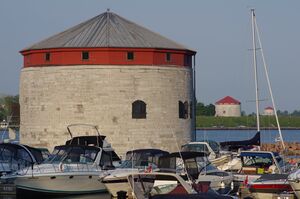
Kingston, being strategically located at the head of the St. Lawrence River and at the mouth of the Cataraqui River near the border with the United States, has been a site of military importance since Fort Frontenac was built in 1673. The French and, later, the British established military garrisons. The War of 1812 led to the bolstering of military troops, the servicing of ships, and the building of new fortifications to defend the town and the Naval Dockyard. Forts were constructed on Point Henry and at Point Frederick. A picket wall, or stockade, incorporating five blockhouses was built to the west of the town, and batteries were constructed.[49][50] In November 1812 American naval forces attacked the British sloop Royal George in Kingston harbour but the ship took refuge in the harbour and the American forces withdrew.[51]
Several defensive fortifications were constructed in the late 1840s because of tensions with the United States. These include Fort Henry, four Martello towers (Cathcart Tower, Shoal Tower, Murney Tower, and Fort Frederick), and the Market Battery. Military ships were built at the Naval Dockyard at Point Frederick from 1788 to 1853. The peninsula near the entrance of the later Royal Military College of Canada was the headquarters of the Royal Navy in between 1813 and 1853. (Fort Frederick, built in 1812–13, was also on this peninsula.)[52]
After the British army withdrew from most locations in Canada in 1870–71, two batteries of garrison artillery were formed by the Dominion Government; the "A" Battery was in Kingston at Fort Henry and Tête du Pont Barracks (Fort Frontenac). (The other battery was in Quebec City)[20] The batteries were also schools of gunnery. Designated as the Regiment of Canadian Artillery, the regular component evolved into the Royal Canadian Horse Artillery. Most of its battery remained housed at Tête du Pont Barracks until 1939.[53]
Following the withdrawal of British forces from Canada in 1870–71, the federal government recognized the need for an officer training college in Canada. In 1874, during the administration of the Hon. Alexander Mackenzie, enabling legislation was passed. Located on Point Frederick, the site of the former Royal Naval Dockyard,
Before a formal college was established in 1876, there were proposals for military colleges in Canada. Staffed by British Regulars, students underwent a military course in 1865 at the School of Military Instruction in Kingston. The school enabled officers of militia or candidates for commission or promotion in the militia to learn military duties, drill and discipline, to command a company at Battalion Drill, to Drill a Company at Company Drill, the internal economy of a Company and the duties of a Company's Officer.[54] The school was retained at Confederation, in 1867.[55]
The withdrawal of imperial troops required a Canadian location for the training of military officers. Because of Kingston's military tradition and the fact several military buildings already existed at the old naval dockyard, Point Frederick was chosen as the location for Canada's first military college, the Royal Military College of Canada (RMC). The facility, called simply The Military College until 1878, opened on Point Frederick with 18 students in 1876[20] under Lt.-Col. Edward O. Hewett, R.E. providing cadets with academic and military training. In 1959, it became the first military college in the Commonwealth with the right to confer University degrees.[56]
Located east of Kingston's downtown, the army's Camp Barriefield, now McNaughton Barracks, was constructed at the beginning of the World War I and expanded during the World War II. Camp Barriefield was named in honour of Rear-Admiral Robert Barrie (May 5, 1774 – June 7, 1841), a British naval officer noted for his service in the War of 1812. It was later named McNaughton Barracks after Andrew George Latta McNaughton, a former minister of national defence. Nearby Vimy Barracks was established in 1937 for the Royal Canadian Corps of Signals (later the Royal Canadian School of Signals). Vimy and McNaughton Barracks house the Canadian Forces School of Communications and Electronics (CFSCE), the Canadian Forces' military communications training centre and several other units. McNaughton Barracks and Vimy Barracks make up most of Canadian Forces Base Kingston (CFB Kingston). Major military facilities supported by CFB Kingston include Fort Frontenac, on the site of the original fort, and the Royal Military College of Canada.
The Princess of Wales' Own Regiment has been a fixture in the City of Kingston since 1863.[57] The PWOR operates as a Primary Reserve Regiment, its members drawn from the Kingston and area community.
During the First World War, the 21st Battalion was formed and saw action in France in 1915 resulting in 18 battle honours including their role in the Battle of Vimy Ridge. The Royal Canadian Horse Artillery also fought in Europe with the 2nd Canadian Division, taking part in 13 major battles. Fort Henry became an internment camp for enemy aliens from August 1914 to November 1917.[20]
During the Second World War the Stormont, Dundas and Glengarry Highlanders (SD&G), mobilized in June 1940. During fighting, troops that had formed in Kingston received recognition from the government for their achievements. Fort Henry was again an internment camp (Camp 31) from September 1939 to December 1943.[58] .[20] A military aerodrome, RCAF Station Kingston, was constructed to the west of Kingston to support flying training.
Geography and climate
Kingston is within the Mixedwood Plains Ecozone, and is dominated in the Kingston area by a mixture of deciduous and coniferous tree species and abundant water resources.[59][60] The region is underlain mostly by Ordovician limestone of the Black River Group.[61]
Being within hardiness zone 5, Kingston has a moderate humid continental climate (Köppen climate classification Dfb).[62] It has cooler summers and colder winters than most of Southern Ontario. Although proximity to Lake Ontario has a moderating effect on the climate, it also tempers the heat and can on occasion increase precipitation, especially during heavy snowfall events. Mild to strong breezes blowing off Lake Ontario make Kingston one of the most consistently windy cities in Canada, especially near the water. As a result of the moderation the all-time high is a relatively modest 35.6 °C (96 °F) recorded on July 9, 1936.[63] However, due to the humidity, the humidex values for such days are very high. The coldest temperature ever recorded in Kingston was −35.6 °C (−32 °F) on February 17, 1896.[64]
The central part of the city is between the Cataraqui River to the east and the Little Cataraqui Creek to the west, with outlying areas extending in both directions. The eastern part of the city is accessible by the La Salle Causeway on Highway 2.
Major features of Kingston's waterfront include Flora MacDonald Confederation Basin, Portsmouth Olympic Harbour, Collins Bay, Wolfe Island, Garden Island, the Cataraqui River (including the Inner Harbour and, within that, Anglin Bay).
| بيانات المناخ لـ Kingston, 1981–2010 normals,[أ] extremes 1872–present[ب] | |||||||||||||
|---|---|---|---|---|---|---|---|---|---|---|---|---|---|
| الشهر | ينا | فب | مار | أبر | ماي | يون | يول | أغس | سبت | أكت | نوف | ديس | السنة |
| القصوى القياسية °س (°ف) | 13.5 (56.3) |
14.4 (57.9) |
24.0 (75.2) |
30.7 (87.3) |
31.7 (89.1) |
35.0 (95.0) |
35.6 (96.1) |
34.5 (94.1) |
33.3 (91.9) |
25.1 (77.2) |
21.1 (70.0) |
16.1 (61.0) |
35.6 (96.1) |
| متوسط القصوى اليومية °س (°ف) | −3.1 (26.4) |
−2.1 (28.2) |
2.9 (37.2) |
10.3 (50.5) |
16.4 (61.5) |
21.7 (71.1) |
24.9 (76.8) |
24.1 (75.4) |
19.5 (67.1) |
13.1 (55.6) |
7.0 (44.6) |
0.8 (33.4) |
11.3 (52.3) |
| المتوسط اليومي °س (°ف) | −7.6 (18.3) |
−6.6 (20.1) |
−1.6 (29.1) |
5.7 (42.3) |
11.8 (53.2) |
17.0 (62.6) |
20.4 (68.7) |
19.6 (67.3) |
15.0 (59.0) |
8.9 (48.0) |
3.2 (37.8) |
−3.3 (26.1) |
6.9 (44.4) |
| متوسط الدنيا اليومية °س (°ف) | −12 (10) |
−11.1 (12.0) |
−6.1 (21.0) |
1.1 (34.0) |
7.1 (44.8) |
12.3 (54.1) |
15.8 (60.4) |
15.1 (59.2) |
10.5 (50.9) |
4.5 (40.1) |
−0.6 (30.9) |
−7.4 (18.7) |
2.4 (36.3) |
| الصغرى القياسية °س (°ف) | −34.5 (−30.1) |
−35.6 (−32.1) |
−27.8 (−18.0) |
−17.2 (1.0) |
−6.1 (21.0) |
0.6 (33.1) |
6.0 (42.8) |
3.3 (37.9) |
−1.7 (28.9) |
−7.5 (18.5) |
−25.6 (−14.1) |
−34.4 (−29.9) |
−35.6 (−32.1) |
| متوسط تساقط الأمطار mm (inches) | 65.2 (2.57) |
65.1 (2.56) |
69.2 (2.72) |
87.1 (3.43) |
76.9 (3.03) |
72.0 (2.83) |
64.0 (2.52) |
93.7 (3.69) |
89.7 (3.53) |
92.4 (3.64) |
100.3 (3.95) |
84.1 (3.31) |
959.6 (37.78) |
| متوسط تساقط الأمطار mm (inches) | 29.2 (1.15) |
29.0 (1.14) |
41.3 (1.63) |
77.5 (3.05) |
76.9 (3.03) |
72.0 (2.83) |
64.0 (2.52) |
93.7 (3.69) |
89.7 (3.53) |
91.0 (3.58) |
92.4 (3.64) |
52.2 (2.06) |
808.7 (31.84) |
| متوسط هطول الثلج cm (inches) | 39.5 (15.6) |
39.1 (15.4) |
25.4 (10.0) |
8.1 (3.2) |
0.0 (0.0) |
0.0 (0.0) |
0.0 (0.0) |
0.0 (0.0) |
0.0 (0.0) |
1.2 (0.5) |
8.0 (3.1) |
35.9 (14.1) |
157.1 (61.9) |
| Average precipitation days (≥ 0.2 mm) | 16.1 | 13.9 | 12.8 | 13.5 | 12.9 | 11.4 | 9.3 | 11.1 | 12.3 | 13.7 | 16.2 | 15.8 | 159.1 |
| Average rainy days (≥ 0.2 mm) | 5.4 | 5.1 | 8.2 | 11.9 | 12.9 | 11.4 | 9.3 | 11.1 | 12.3 | 13.6 | 14.0 | 8.1 | 123.4 |
| Mean monthly ساعات سطوع الشمس | 93.2 | 113.1 | 144.2 | 161.8 | 218.0 | 243.7 | 279.3 | 238.7 | 164.4 | 139.7 | 89.5 | 73.1 | 1٬958٫8 |
| نسبة السطوع المحتمل للشمس | 32.4 | 38.5 | 39.1 | 40.2 | 47.7 | 52.6 | 56.5 | 55.0 | 43.7 | 40.9 | 30.9 | 26.4 | 42.2 |
| Source: Environment Canada[65][66][67][68][69] | |||||||||||||
Sports
Notable people
Media
See also
References
Notes
- ^ Normals are based on climate data recorded at Kingston/Norman Rogers Airport from 1981 to 1996.
- ^ Extreme high and low temperatures in the table below were recorded at Queen's University from July 1872 to March 1957, at Kingston (Ontario Hydro) from April 1957 to June 1967, at Kingston/Norman Rogers Airport from July 1967 to September 1996, at Kingston Pumping Station from October 1996 to November 2007 and at Kingston/Norman Rogers Airport from July 2008 to present.
- ^ "Ottawa Valley election results: Mayoral Races". CTV Ottawa. أكتوبر 28, 2014. Archived from the original on نوفمبر 4, 2014. Retrieved نوفمبر 4, 2014.
- ^ "Population and Dwelling Count Highlight Tables, 2016 Census". Statistics Canada. فبراير 8, 2017. Archived from the original on فبراير 11, 2017. Retrieved فبراير 8, 2017.
- ^ "Table 36-10-0468-01 Gross domestic product (GDP) at basic prices, by census metropolitan area (CMA) (x 1,000,000)". Statistics Canada. Archived from the original on يناير 22, 2021. Retrieved أبريل 27, 2021.
- ^ Preston, Richard A., ed. (1959). Kingston before the War of 1812: A Collection of Documents (Ontario Series). The Publications of the Champlain Society. p. 37. doi:10.3138/9781442618503. ISBN 978-1-4426-1850-3.
- ^ Osborne 2011, p. 81
- ^ Quebec History – Cataraqui Archived مارس 4, 2016 at the Wayback Machine Retrieved April 12, 2014
- ^ Cataraqui Archaeological Research Foundation Archived أبريل 13, 2014 at the Wayback Machine Retrieved April 12, 2014
- ^ Histoires de Bâtiment – Naval Historic Sites – Kingston Archived أبريل 13, 2014 at the Wayback Machine Retrieved April 12, 2014
- ^ All About Canada, Kingston, Ontario-Settlement and Early Days Archived أبريل 13, 2014 at the Wayback Machine Retrieved April 12, 2014
- ^ أ ب Brown, Ron (2011). Hidden Ontario: Secrets from Ontario's Past. Toronto: Dundurn. pp. 98–100. ISBN 978-1554889556. Archived from the original on مارس 28, 2018.
- ^ Armstrong 1973, p. 67.
- ^ "Chronology of the History of Kingston". Kingston Historical Society. Archived from the original on أبريل 26, 2012. Retrieved يونيو 28, 2012.
- ^ Archaeology in the County – Traces of the First People in Prehistoric Prince Edward County Archived مارس 9, 2013 at the Wayback Machine Retrieved March 4, 2015
- ^ The Archaic Period. Ontario Archaeological Society Archived نوفمبر 16, 2012 at the Wayback Machine Retrieved March 4, 2015
- ^ Late Woodland Period. Ontario Archaeological Society Archived سبتمبر 14, 2013 at the Wayback Machine Retrieved March 4, 2015
- ^ أ ب Kingston Archaeology – Belle Island Archived فبراير 27, 2015 at the Wayback Machine Retrieved February 27, 2015
- ^ Adams 1986, p. 6
- ^ Adams 1986, pp. 5, 9
- ^ Osborne 2011, pp. 13, 19
- ^ أ ب ت ث ج ح خ د ذ ر ز س ش ص ض "Kingston Historical Society Chronology of the History of Kingston". Archived from the original on أبريل 26, 2012.
- ^ A History of Fort Frontenac Archived أغسطس 6, 2014 at the Wayback Machine Retrieved December 8, 2017
- ^ أ ب Osborne 2011, p. 18
- ^ Osborne 2011, pp. 19–21
- ^ "The Crawford Purchase". Ontario's Historical Plaques. Archived from the original on ديسمبر 19, 2018. Retrieved ديسمبر 18, 2018.
- ^ Osborne 2011, p. 22
- ^ Preston, Richard A., ed. (1959). Kingston before the War of 1812: A Collection of Documents (Ontario Series). The Publications of the Champlain Society. p. 49. doi:10.3138/9781442618503. ISBN 978-1-4426-1850-3.
- ^ Osborne 2011, p. 23
- ^ "Loyalist Landing at Cataracoui 1784". Ontario's Historical Plaques. Archived from the original on ديسمبر 19, 2018. Retrieved ديسمبر 18, 2018.
- ^ Boyle, Terry (مايو 30, 2011). Hidden Ontario: Secrets from Ontario's Past. Dundurn. ISBN 9781459700291. Archived from the original on مارس 28, 2018 – via Google Books.
- ^ أ ب "Fort Henry Historical Plaque". ontarioplaques.com. Archived from the original on أبريل 26, 2017.
- ^ Mika 1987, p. 68.
- ^ Ontario Heritage Plaque – Fort Henry Archived سبتمبر 24, 2015 at the Wayback Machine Retrieved September 2, 2015
- ^ Osborne 2011, pp. 150–154
- ^ "Regiopolis College". Ontario's Historical Plaques. Archived from the original on ديسمبر 19, 2018. Retrieved ديسمبر 18, 2018.
- ^ "Queen's University". Ontario's Historical Plaques. Archived from the original on ديسمبر 19, 2018. Retrieved ديسمبر 18, 2018.
- ^ "Legislature of the Province of Canada 1841–1844". Ontario's Historical Plaques. Archived from the original on ديسمبر 19, 2018. Retrieved ديسمبر 18, 2018.
- ^ "Kingston City Hall Historical Plaque". ontarioplaques.com. Archived from the original on أبريل 26, 2017.
- ^ "Kingston Penitentiary". Ontario's Historical Plaques. Archived from the original on ديسمبر 19, 2018. Retrieved ديسمبر 18, 2018.
- ^ Smith, Wm. H. (1846). Smith's Canadian Gazetteer – Statistical and General Information Respecting All Parts of The Upper Province, or Canada West. Toronto: H. & W. ROWSELL. pp. 91–93. Archived from the original on أبريل 3, 2016. Retrieved مايو 13, 2017.
- ^ "Hotel Dieu and the Religious Hospitallers of St. Joseph – STONES". www.stoneskingston.ca. Archived from the original on أبريل 25, 2017.
- ^ "The Typhus Epidemic 1847". Ontario's Historical Plaques. Archaeological and Historic Sites Board of Ontario. Archived from the original on أكتوبر 19, 2013. Retrieved يناير 24, 2012.
- ^ "Kingston General Hospital National Historic Site of Canada". Parks Canada. Government of Canada. Archived from the original on July 1, 2013. Retrieved February 12, 2013.
- ^ The Province of Ontario Gazetteer and Directory. Robertson & Cook. 1869. p. 243. Archived from the original on مارس 6, 2016. Retrieved ديسمبر 18, 2018.
- ^ "Fire and gunpowder explosions demolished Kingston's waterfront". Kingston Whig-Standard. فبراير 8, 2010. Archived from the original on يناير 3, 2018. Retrieved ديسمبر 18, 2018.
- ^ Kingston Public Market History Archived يونيو 19, 2015 at the Wayback Machine Retrieved October 8, 2015
- ^ Osborne 2011, p. 99
- ^ City receives grant to complete Brownfield study of Davis Tannery lands. Kingstonregion.com. October 23, 2013. Retrieved September 22, 2015[dead link]
- ^ Mika 1987, p. 124
- ^ Osborne 2011, p. 50
- ^ Mika 1987, p. 44
- ^ "The Escape of the Royal George". Ontario's Historical Plaques. Archived from the original on ديسمبر 9, 2017. Retrieved ديسمبر 8, 2017.
- ^ "Point Frederick Buildings". Ontario's Historical Plaques. Archived from the original on ديسمبر 19, 2018. Retrieved ديسمبر 18, 2018.
- ^ The Victorian Soldier – History and Uniform of the Royal Canadian Horse Artillery, 1871 to 1970 Archived سبتمبر 26, 2011 at the Wayback Machine Retrieved September 10, 2011
- ^ "RootsWeb.com Home Page". freepages.genealogy.rootsweb.ancestry.com. Archived from the original on أبريل 7, 2016. Retrieved يونيو 7, 2016.
- ^ Richard Preston 'Canada's RMC: A History of the Royal Military College of Canada' published by the RMC Club by U of Toronto Press.
- ^ "The Royal Military College of Canada". Ontario's Historical Plaques. Archived from the original on ديسمبر 19, 2018. Retrieved ديسمبر 18, 2018.
- ^ "A Short History of the POWR: The Princess of Wales' Own Regiment: A Glimpse at 150 years, 1863–2013" (PDF). ديسمبر 22, 2013. Archived from the original (PDF) on مايو 12, 2018. Retrieved مايو 11, 2018.
- ^ "Internment Camps in Canada during the First and Second World Wars". Library and Archives Canada. Archived from the original on سبتمبر 5, 2014. Retrieved سبتمبر 5, 2014.
- ^ Ecological Framework of Canada – Mixedwood Plains Ecozone Archived مارس 15, 2016 at the Wayback Machine. Retrieved April 30, 2016
- ^ Landforms and Climate of the Mixedwood Plains Ecozone. (Archived). Retrieved April 30, 2016
- ^ Chapman, L.J. and D.F. Putnam. The Physiography of Southern Ontario. University of Toronto Press, 1973. pp 62, 316.
- ^ "Kingston, Ontario Climate Summary". Weatherbase. Archived from the original on مارس 4, 2016. Retrieved يناير 3, 2016.
- ^ "Canadian Climate Data". Government of Canada. Archived from the original on أغسطس 29, 2016. Retrieved أغسطس 27, 2016.
- ^ "Canadian Climate Data". Government of Canada. Archived from the original on أغسطس 29, 2016. Retrieved أغسطس 27, 2016.
- ^ "Kingston A". Canadian Climate Normals 1981–2010. Environment Canada. Retrieved سبتمبر 22, 2013.
- ^ "Kingston Pumping Station". Government of Canada. Archived from the original on يونيو 17, 2016. Retrieved مايو 20, 2016.
- ^ "Kingston Ont Hydro". Government of Canada. Archived from the original on أغسطس 29, 2016. Retrieved أغسطس 27, 2016.
- ^ "Kingston Queens U". Government of Canada. Archived from the original on أغسطس 29, 2016. Retrieved أغسطس 27, 2016.
- ^ "Kingston Climate". Government of Canada. Archived from the original on أغسطس 29, 2016. Retrieved أغسطس 27, 2016.
Bibliography
- Adams, Nick.Iroquois Settlement at Fort Frontenac in the Seventeenth and Early Eighteenth Centuries. Ontario Archaeology, No. 46: 4–20. 1986.
- Armstrong, Alvin. Buckskin to Broadloom – Kingston Grows Up. Kingston Whig-Standard, 1973. No ISBN.
- Mika, Nick and Helma et al. Kingston, Historic City. Belleville: Mika Publishing Co., 1987. ISBN 0-921341-06-7.
- Mika, Nick and Helma. Kingston Heritage, Buildings, Monuments, Plaques Belleville: Mika Publishing Co., 1983, 160 pages.
- Osborne, Brian S. and Donald Swainson. Kingston, Building on the Past for the Future. Quarry Heritage Books, 2011. ISBN 1-55082-351-5
- Roy, James. Kingston: The King's Town. Toronto: McClelland and Stewart, 1952.
- Turner, Larry. "The Founding of Kingston, Ontario". The Loyalist Gazette, Volume XXII, No. 1. Retrieved 2015-01-14
- Preston, Richard. Kingston Before the War of 1812: A Collection of Documents. Toronto: Champlain Society Publications, 1959.
External links
 Kingston, Ontario travel guide from Wikivoyage
Kingston, Ontario travel guide from Wikivoyage- Official City of Kingston website
- Pages using gadget WikiMiniAtlas
- Articles with dead external links from December 2018
- Short description with empty Wikidata description
- Use Canadian English from January 2020
- All Wikipedia articles written in Canadian English
- Use mdy dates from June 2018
- Pages using infobox settlement with possible motto list
- Coordinates not on Wikidata
- Articles with hatnote templates targeting a nonexistent page
- كنگستون، أونتاريو
- Venues of the 1976 Summer Olympics
- Former colonial capitals in Canada
- Populated places on Lake Ontario in Canada
- Ontario populated places on the Saint Lawrence River
- Single-tier municipalities in Ontario
- Thousand Islands

